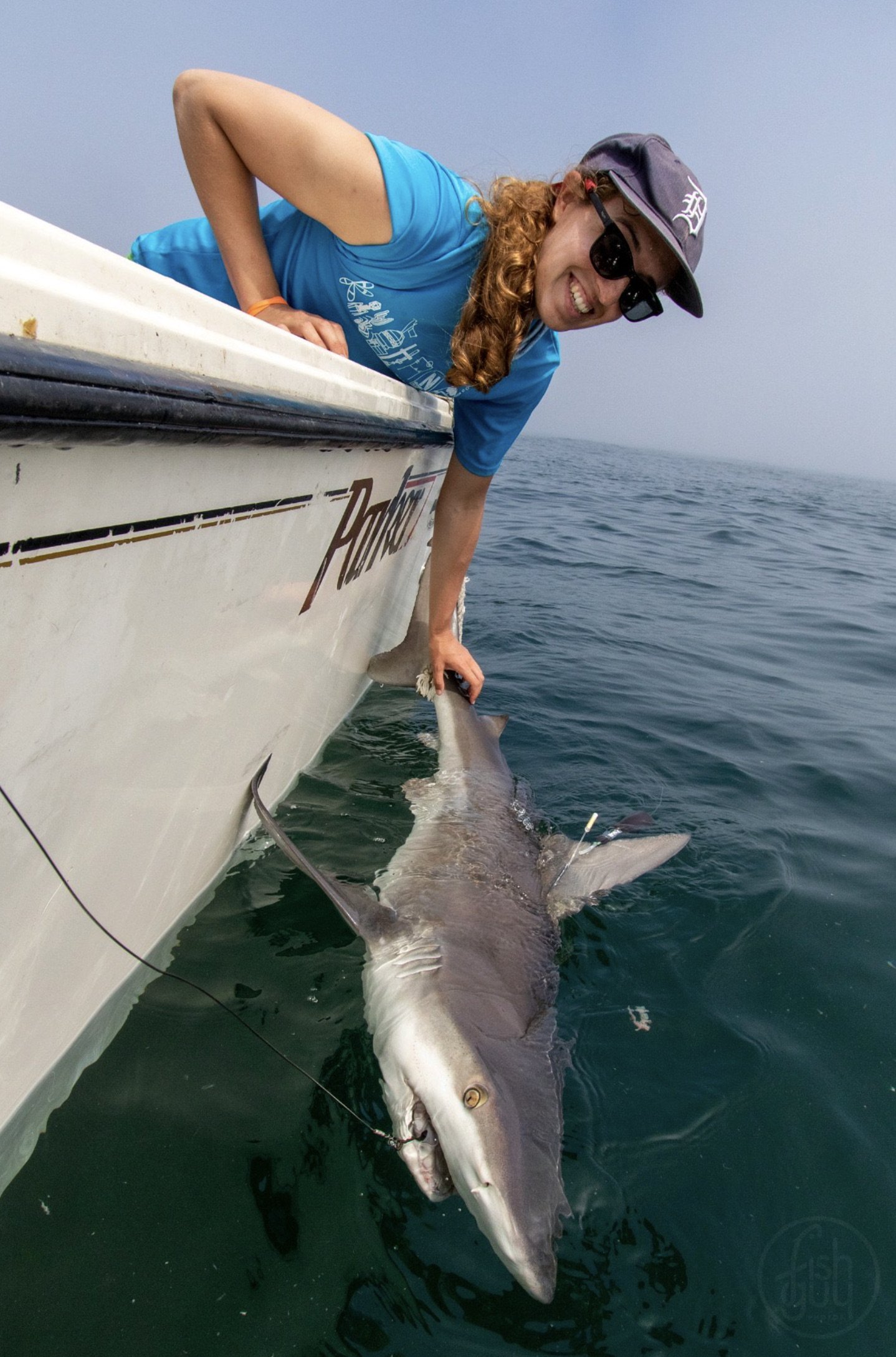
The safe and humane way to take a shark selfie. Photo courtesy of The South Fork Natural History Museum and Nature Center – www.sofo.org
IF YOU LIVE ON Long Island and have taken a swim in one of the numerous saltwater waterways this summer, chances are you were near a shark. Surrounded by the great Atlantic Ocean, Long Island is home to numerous inlets, bays, and back-bay salt marshes. Living on the Island gives any resident access to all of these waterways by boat, car, or on foot. That is where the greatest summer attraction comes into play, the beach. With the Atlantic Ocean funneling into these inlets and bays, there has been a recent spike in shark activity around the Long Island bays. With this increase, a trend has begun of people taking pictures with sharks they see around the beaches, or catch while fishing.
Frank Quevedo, executive director of the South Fork Natural Education Program (SOFO), explained that the increase is due to a few reasons. The first is an increase in bait fish, more specifically Atlantic Menhaden, more commonly known as bunker. “They (sharks) will go where the food is,” Quevedo said. “Climate change is also bringing about warmer water,” which is another reason for the shark increase in the bays around Long Island, according to Quevedo.
Most of the time when people take these pictures with sharks, they remove them from the water. Dr. Arthur Kopelman, president of the Coastal Research and Education Society of Long Island (CRESLI), described it as “tantamount to torture.” Whether people are catching these sharks from the beach, or picking them up to take pictures, they are harming them. “A shark needs to keep swimming constantly to get oxygen,” Quevedo, who is part of the SOFO Shark Research and Education Program, explained. “You can compare it in a similar way to a human drowning, it’s very stressful for the fish.”
It often slips the mind of people that when you enter the water, you are entering the habitat of the sharks. These bays are “developmental shark nurseries,” according to Quevedo. Most of these sharks are mere juveniles and a lot of them are prohibited species. When you take these sharks out of the water, you are depriving them of the oxygen that they need. Quevedo and his team often catch sharks to collect DNA samples and run tests. However, they always make sure to hold them in the water along- side the boat with the current of the water to ensure enough oxygen is reaching the shark’s gills. The average person catching them or picking them up for a picture is not doing that. “It’s like a prize, people want to show off their shark catch on Tik Tok and Instagram; after being released, those sharks will likely die a little later on,” Quevedo explained. It’s like bycatch, which is when commercial fishermen snag sharks in their nets and drag them backward, it drowns them and then they just discard the shark.
“Shark species are so important to our ecosystem, they are a keystone species,” Quevedo stated. “The sharks control prey populations and eat sick fish, without them, the ecosystem would crash.” Sharks have been around for millions of years, there’s a reason for it and it is easy to spot their importance. While Quevedo doesn’t believe it could have a long-term effect on the population, harming and even killing sharks for a picture is quite silly. “I’m a big fisherman, I love catching fish like bluefish and striped bass, but I sympathize with the sharks, they are such beautiful creatures,” Quevedo said while explaining how he feels when he comes across pictures of sharks being caught.
Not only is it harmful to the sharks, but it can also be harmful for humans to pick them up too. People often forget that even though they might be juveniles, these are sharks, with teeth, that eat prey. On Thursday, July 27, a source told Fire Island News that a day camp counselor at Ocean Beach Youth Group grabbed a shark out of the bay and was bitten. The counselor required medical treatment. The Youth Group made the following comment, “We are very happy no campers were involved and that the counselor was fine and back at work the next day.” While thankfully it does not appear to be anything major, it is a subtle reminder that you are putting yourself in harm’s way when you interact with these sharks.
Quevedo says that his message is, “People should be educated,” on sharks and the harmful effects human interaction can have on them. The New York State Department of Environmental Conservation has a lot of information on the different types of shark species around Long Island and their level of conservation status. The SOFO Shark Research and Education Program is another great site with loads of information on sharks, and you can follow along with Quevedo and his team.
The next time you’re fishing, think twice before you pull that dogfish (a type of shark) you accidentally caught out of the water. If you’re just enjoying your day at the beach and see a juvenile shark hanging around, leave it be. Perhaps the next time you see a person extract a shark from the water for a picture, you can explain the harmful effects they are causing to the shark and the ecosystem. Your shark selfie, can cause a lot of harm to creatures that have been around since prehistoric times.




























